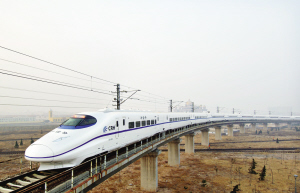I can’t find anything that says the Canton Fair is the largest trade show in the world, but I suspect it is, at least by some measure. It’s far larger than any other I’ve attended, and I’ve been to at least a few large ones (remember Comdex?).
The Canton Fair, officially called the China Import and Export Fair is held at the China Foreign Trade Centre. This complex is over 1/2 mile long and comprises 16 halls, most of which contain multiple floors (up to 4).
A snapshot can’t start to show the scale of this place because it can only show a small percentage of the buildings.
This walkway is between two sections of the facility. It’s at least a quarter mile long, but is only abut half as long as the main walkway down the center of the building.
Because of a lack of space, the fair must be held in three phases, with the product categories split between phases. Each phase is 5 days long with a three day break between to change exhibits to the different product categories. Following are the product categories. Note that they are not too restrictive.
Phase 1
- Electronics & Household Electrical Appliances
- Lighting Equipment
- Vehicles & Spare Parts
- Machinery
- Hardware & Tools
- Building Materials
- Chemical Products
Phase 2
- Consumer Goods
- Gifts
- Home Decorations
Phase 3
- Textiles & Garments
- Shoes
- Office Supplies, Cases & Bags, and Recreation Products
- Medicines, Medical Devices and Health Products
- Food
What’s to see?
Here is a view of one of the halls from one level up.
Note the product category is ‘large machinery’. Not ‘metalworking machinery’, or such like. That’s a pretty broad category and that is born out by the types of machinery on exhibition.
Need to make rope? That’s an interesting machine.
Fill a bottle? There were all manner of package making and filling machines.
Make Oreos? This machine adds the crème filling between the two cookies.
Make concrete. Some vendors used models, but the real thing is outside.
Yes, there were metalworking machines too,
Plus food mixers and press brakes.
And diaper-making machines.
In summary, everything you can imagine. And this is in just one hall.
There were the usual Chinese safety guards. The plastic shield around the sides of this red hot induction heated steel rod provides plenty of protection.
And it’s only needed because the whole display is in the isle of the trade show. Look mom, what a pretty red…
And the usual great slogans.
SIEG had a booth there.
One of the amazing things about large gatherings of people in China is the lack of waiting in lines. We registered for the show in about 10 minutes, including meeting with three different departments because they couldn’t figure out what to do with us.
I’m guessing there were 150,000 attendees there, yet we waited abut two minutes for lunch in the largest food court I have ever seen. It’s about the size of a football field. This photo is taken from the center of the room. There are at least two McDonalds in this exhibition complex.
We worked pretty hard to get through the sections we need to see, which were large machinery, small machinery, and tools. We only had a little time for the fun stuff like consumer electronics, motorcycles, construction equipment, and computers.
Weight lifting equipment
In-line skateboards.
You can’t just put the babies in the bicycle basket…
A pink scooter anyone? ((We saw one of these on the street in Shanghai)
Just writing this makes my feet sore. We figured we put in over 10 miles a day. That’s enough.
























































